GHGRP 2012: Reported Data
For reporting year (RY) 2012, over 8,000 facilities and suppliers reported to the greenhouse gas reporting program. Among these reporters,
- 7,809 facilities in nine industry sectors reported direct emissions
- Emissions totaled 3.13 billion metric tons carbon dioxide equivalent (CO2e), about half of total U.S. greenhouse gas emissions.
Summary GHGRP data has been broken into several sections. Click the links below to expand each section.
- Greenhouse Gas Reporting Program Background
As directed by Congress, EPA’s Greenhouse Gas Reporting Program (GHGRP) collects annual greenhouse gas information from the top emitting sectors of the U.S. economy (Table 1). The GHGRP is the only dataset containing facility-level greenhouse gas (GHG) emissions data from major industrial sources across the United States. With three years of reporting for most sectors, GHGRP data are providing important new information on industrial emissions—showing variation in emissions across facilities within an industry, variation in industrial emissions across geographic areas, and changes in emissions over time at the sector and facility level. EPA is using this facility-level data to improve estimates of national greenhouse gas emissions, including using it to improve the U.S. Greenhouse Gas Inventory. The data are also being used to inform regulatory actions and voluntary emission reduction efforts.
This document summarizes national industrial sector emissions and trends.
Table 1: GHGRP Sector Classifications
Industry Sector Number of Reporters Emissions
(million metric tons CO2e)Power Plants 1,611 2,090 Petroleum and Natural Gas Systems 2,058 217 • Onshore Petroleum & Nat. Gas Prod. 497 88 • Offshore Petroleum & Nat. Gas Prod. 106 6.5 • Natural Gas Processing 394 60 • Natural Gas Trans./Compression 462 23 • Underground Natural Gas Storage 49 1.3 • Natural Gas Local Distribution Co. 174 13 • Liquefied Natural Gas Imp./Exp. Eq. 8 0.6 • Liquefied Natural Gas Storage 4 ** • Other Petroleum & Nat. Gas Systems 381 24 Refineries 144 173 Chemicals 463 170 Non-Fluorinated Chemicals • Adipic Acid Production 3 7.4 • Ammonia Manufacturing 22 25 • Hydrogen Production 106 39 • Nitric Acid Production 36 11 • Petrochemical Production 65 52 • Phosphoric Acid Production 12 2.1 • Silicon Carbide Production 1 0.1 • Titanium Dioxide Production 7 2.1 • Other Chemicals Production 219 19 Fluorinated Chemicals • Fluorinated GHG Production 16 7.4 • HCFC-22 Prod./HFC-23 Dest. 5 4.3 Waste 1,611 100 • Industrial Waste Landfills 176 8.2 • Municipal Landfills 1,217 79 • Solid Waste Combustion 69 10 • Industrial Wastewater Treatment 155 3 Metals 297 107 • Aluminum Production/td> 10 6.5 • Ferroalloy Production 10 2.4 • Iron and Steel Production 125 84 • Lead Production 14 1.1 • Magnesium Production 10 1.7 • Zinc Production 6 1.0 • Other Metals Production 122 9.7 Minerals 369 107 • Cement Production 96 60 • Glass Production 107 8.2 • Lime Manufacturing 74 30 • Soda Ash Manufacturing 4 5.2 • Other Minerals 89 3.8 Pulp and Paper 232 42 • Pulp and Paper Manufacturing 110 30 • Other Paper Producers 122 12 Other 1,419 123 • Food Processing 31 30.8 • Ethanol Production 166 17 • Manufacturing 285 16 • Universities 113 8.9 • Military 44 2.6 • Other Combustion 166 11 • Underground Coal Mines 151 28 • Electronics Manufacturing 53 5.1 • Electrical Equipment Manufacturers 6 0.2 • Electrical Equipment Use 123 3.4 a The data presented here reflects data reported to the GHGRP as of 9/1/2013.
bBiogenic emissions are NOT included in the total emissions.
** Total reported emissions are less than 0.05 million metric tons CO2e.The GHGRP does not represent total U.S. GHG emissions, but provides facility level data for large sources of direct emissions, thus including the majority of U.S. GHG emissions. The GHGRP data collected from direct emitters represent about half of all U.S. emissions. When including greenhouse gas information reported by suppliers to the GHGRP, emissions coverage reaches approximately 85–90% (See Figure 1). The Inventory of U.S. Greenhouse Gas Emissions and Sinks: 1990-2012 contains information on all GHG emissions sources and sinks in the United States.
Learn more about the differences between the Inventory and the GHGRP.
Figure 1: U.S. Greenhouse Gas Inventory and the Greenhouse Gas Reporting Program
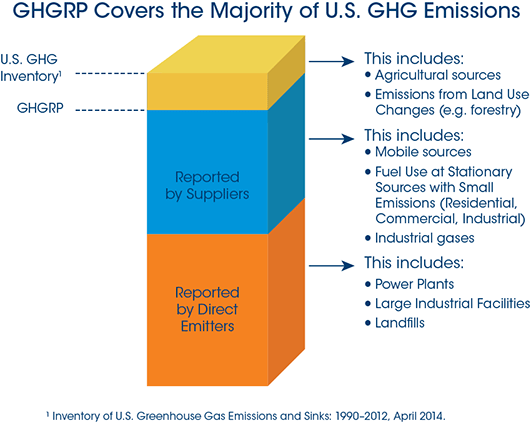
Suppliers are those entities that supply products into the economy that, if combusted, released, or oxidized, would emit GHGs into the atmosphere. Emissions associated with these fuels and industrial gases do not occur at the supplier’s facility but instead occur throughout the country, wherever they are used. An example of this is gasoline, which is supplied into the U.S. economy by a relatively small number of entities and consumed by many individual vehicles throughout the country. The majority of GHG emissions associated with the transportation, residential, and commercial sectors are accounted for by these suppliers. This document focuses on data reported by direct emitters. Data reported by suppliers can be viewed through the suppliers section of the Facility Level Information on GreenHouse gases Tool (FLIGHT).
Table 2: Overview of GHG Data Reported (2012) Direct emitters Number of facilities reported 7,809 Reported direct emissions (billion metric tons CO2e) 3.13 Suppliers of fuel and industrial gases Number of suppliers 883 Underground injection of carbon dioxide Number of carbon dioxide injection facilities 87
- Who reports?
For 2012, 7,809 direct emitters submitted a GHG report. The Petroleum and Natural Gas Systems sector had the largest number of reporting facilities, followed by the Power Plants Sector and the Waste Sector. Among suppliers, Suppliers of Natural Gas and Natural Gas Liquids had the largest number of reporting facilities.
Table 3: Number of Direct Emitters that Reported (2012) Industry Sector Number of Reporters1 Power Plants 1,611 Petroleum and Natural Gas Systems 2,058 Refineries 144 Chemicals 463 • Fluorinated Chemicals 16 • Non-fluorinated Chemicals 447 Waste 1,611 Metals 297 Minerals 369 Pulp and Paper 232 Other 1,419 • Underground Coal Mines 151 • Electrical Equipment Production & Use 129 • Electronics Manufacturing 53 • Other Combustion 1,090 1 Totals sum to more than 7,809 because facilities with production processes in more than one sector are counted multiple times.
Table 4: Number of Suppliers that Reported (2012) Supply Sector Number of Reporters2 Suppliers of Coal-Based Liquid Fuels 1 Suppliers of Petroleum Products 234 Suppliers of Natural Gas and Natural Gas Liquids • Natural Gas Distribution 365 • Natural Gas Liquids Fractionation 119 Suppliers of Industrial GHGs • Industrial GHGs 58 • Imports and Exports of Equipment Pre–charged with Fluorinated GHGs or Containing Fluorinated GHGs in Closed–cell Foams 44 Suppliers of Carbon Dioxide 137 2 Totals sum to more than 883, because suppliers that fall into more than one sector are counted multiple times.
- Reported Emissions
All GHG emissions data, displayed in units of carbon dioxide equivalent (CO2e) reflect the global warming potential (GWP) values from the Intergovernmental Panel on Climate Change (IPCC), Climate Change 1995: The Science of Climate Change (Second Assessment Report (SAR), Cambridge, United Kingdom: Cambridge University Press). The SAR values also can be found in the version of Table A-1 to 40 CFR part 98, published in the Federal Register on October 30, 2009 (74 FR 56395).
In 2012, 3.13 billion metric tons CO2e were reported by direct emitters. The largest emitting sector was the Power Plant Sector with 2.09 billion metric tons CO2e, followed by the Petroleum and Natural Gas Systems Sector with 217 million metric tons (MMT) CO2e and the Petroleum Refinery Sector with 173 MMT CO2e. This information, as well as average emissions per reporter, is shown in the following chart.
Figure 2: Direct GHG Emissions Reported by Sector (2012)
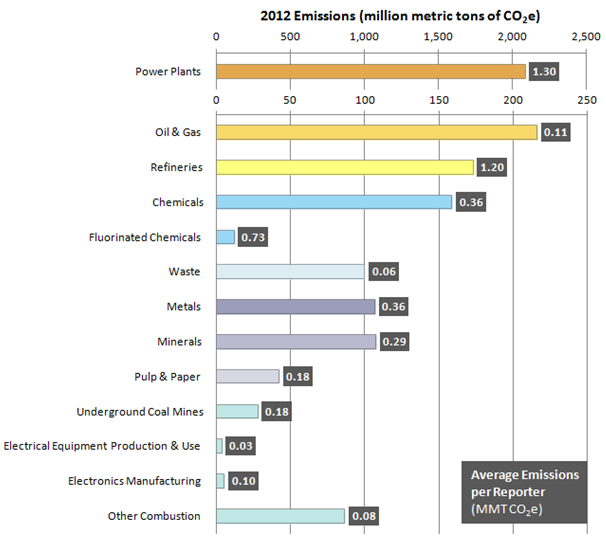
- Emissions Trends
National level trends in greenhouse gas emissions are available through the Inventory of U.S. Greenhouse Gas Emissions and Sinks: 1990-2012. The Greenhouse Gas Reporting Program collects information from the largest stationary sources in the U.S. and provides nearly complete emissions coverage for many of the largest emitting industries. Discussion of the trend in reported emissions from 2010 (or in some cases 2011) to 2012 from individual industries that report to the GHGRP is included in the industry specific reports.
While total U.S. emissions decreased by 1.8% from 2010 to 2011, emissions reported to the GHGRP increased over this period (Table 5). The increase occurred because 12 source categories were required to begin reporting for the first time in 2011. For these industries, 2011 is the appropriate base year for determining trends in reported emissions. Trends for other sectors can be determined using GHGRP data beginning in 2010 (Figure 3).
Total U.S. emissions decreased by 3.4% from 2011 to 2012 based on the Inventory of U.S. Greenhouse Gas Emissions and Sinks: 1990-2012 (April 2014). For facilities that reported to the GHGRP in 2011 and 2012, emissions declined by 4.5% (Table 5). This decline was driven by a 4.7% decline in emissions from power plants. In the two years since reporting began, emissions from power plants have decreased 10 percent.
Table 5: Emissions Trends for U.S. GHG Inventory and GHGRP (2010-2012) 2010 2011 2012 U.S. GHG Inventory Total emissions (million metric tons CO2e) 6,848.6 6,726.6 6,501.5 Percent change in emissions from previous year — -1.8% -3.4% GHGRP Number of direct-emitting facilities 6,267 7,6121 7,809 Direct emissions (million metric tons CO2e) 3,180 3,2751 3,129 Percent change in emissions from previous year — — -4.5% 1 Twelve additional source categories began reporting in 2011.
Table 6: Emission Trends by Sector (2010-2012) Sector 2010 Emissions
(MMT CO2e)2011 Emissions
(MMT CO2e)12012 Emissions
(MMT CO2e)Power Plants 2,330.8 2,221.9 2,090.0 Oil & Gas NR 209.8 217.1 Refineries 177.7 177.9 173.3 Chemicals NR 178.4 170.4 • Fluorinated Chemicals NR 13.9 11.7 • Non-fluorinated Chemicals 156.0 164.5 158.7 Waste NR 98.8 99.9 Metals NR 112.3 106.8 Minerals 101.1 103.2 107.5 Pulp & Paper 45.8 43.8 42.1 Other NR 128.9 122.8 • Underground Coal Mines NR 29.9 27.7 • Electrical Equipment Production & Use NR 4.5 3.6 • Electronics Manufacturing NR 5.6 5.1 • Other Combustion 89.2 88.9 86.4 1 Twelve additional source categories began reporting in 2011.
NR means that emissions are not shown for the 2010 reporting year for sectors in which emissions from some source categories in the sector were not required to be reported in 2010.Figure 3: Trends in Direct GHG Emissions (2010-2012)
View this information in FLIGHT.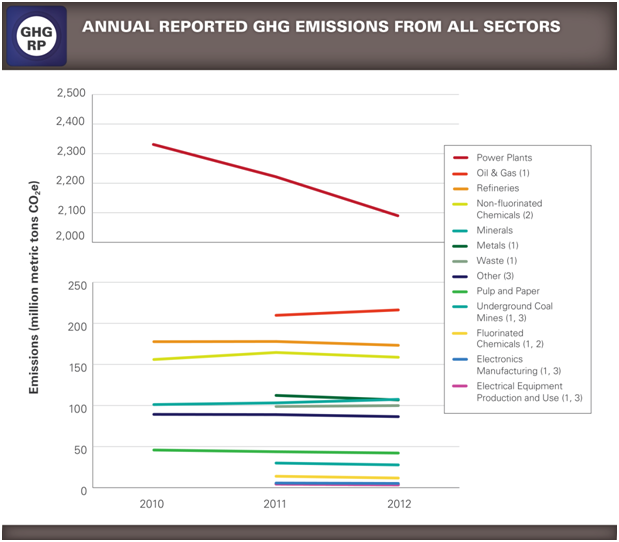
(1) In reporting year 2011, emissions for some processes in this sector were reported for the first time.
(2) Non-fluorinated Chemicals and Fluorinated Chemicals are components of “Chemicals” in FLIGHT.
(3) Other Combustion, Underground Coal Mines, Electronics Manufacturing and Electrical Equipment Production & Use comprise “Other” in FLIGHT.
- Emissions by GHG
Carbon dioxide represented 92.2% of the GHGs reported in 2012. The reported 2.89 billion metric tons represents about 54% of total U.S. CO2 emissions. Reported methane emissions were 192.0 MMT CO2e of methane, representing about 34%1 of total U.S. methane emissions. Facilities reported 29.5 MMT CO2e of N2O, representing about 7%1 of total U.S. N2O emissions. Finally, reported emissions of fluorinated gases (HFCs, PFCs, SF6) represent about 13%1 of U.S. emissions of these compounds.
1 Draft Inventory of U.S. Greenhouse Gas Emissions And Sinks: 1990-2012 (April 2014)
Figure 4: Direct Emissions by GHG (2012)
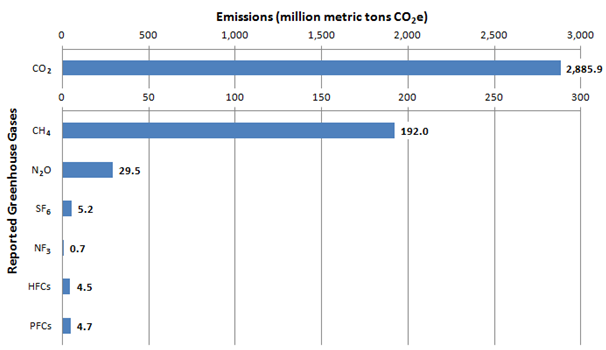
The table below lists the primary sectors emitting each GHG.
1 These source categories account for 75 percent or more of the reported emissions of the corresponding GHG. The subpart under which the emissions were reported is shown in parentheses.Table 7: Largest Sources of GHG Emissions Greenhouse Gas Source Categories Contributing Most to Emissions1 Sectors Contributing Most to Emissions CO2 Electricity Generation (D), Stationary Combustion (C) Power Plants CH4 Municipal Landfills (HH), Petroleum & Natural Gas Systems (W) Waste, Petroleum & Natural Gas Systems N2O Nitric Acid Production (V), Electricity Generation (D), Adipic Acid Production (E) Chemicals, Power Plants SF6 SF6 from Electrical Equipment (DD), Magnesium Production (T) Other, Metals NF3 Electronics Manufacturers (I) Other HFCs HCFC–22 Production and HFC–23 Destruction (O) Chemicals PFCs Aluminum Production (F), Electronics Manufacturers (I) Metals, Other
- Geographic Distribution of Emissions
Figure 5: Location and Total Reported Emissions from GHGRP Facilities (2012)
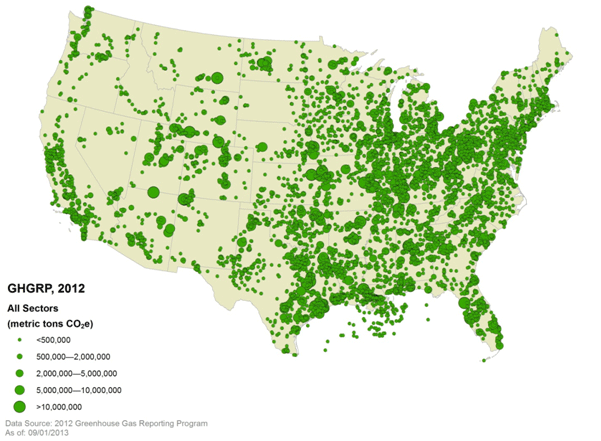
This map shows the locations of direct-emitting facilities. The size of a circle corresponds to the quantity of emissions reported by that facility. There are also facilities located in Alaska, Hawaii, Puerto Rico, the U.S. Virgin Islands, and Guam.
Readers can identify facilities in their state, territory, county, or city by visiting FLIGHT.
Because it generally applies to facilities that emit greater than 25,000 metric tons CO2e per year, the GHGRP provides total reported emissions from large stationary sources in each state. Figure 6 shows the reported emissions in each state broken out by industrial sector.
Figure 6: Direct GHG Emissions by State and Sector (2012)
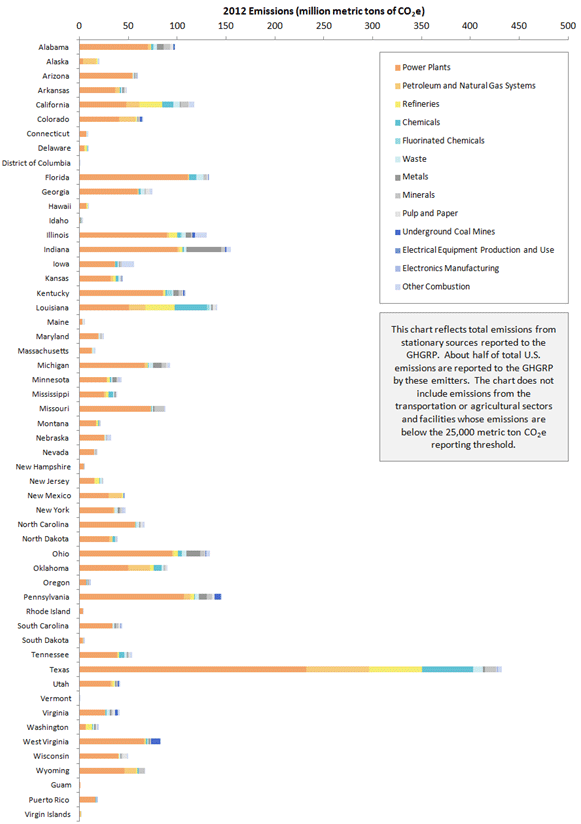
- Emissions Range
The GHGRP provides a comprehensive dataset that can be used to determine the number of facilities at various emissions levels in many industry sectors. The GHGRP can also be used to determine the total GHG emissions from individual facilities, including emissions from fossil fuel combustion and other processes. This information is valuable for planning future policies. GHGRP data provide policy makers with a better understanding of the number of facilities and total emissions that would be covered by potential GHG reduction policies for various industries.
Figure 7: Percentage of All Reporting Facilities at Various Emission Ranges (2012)
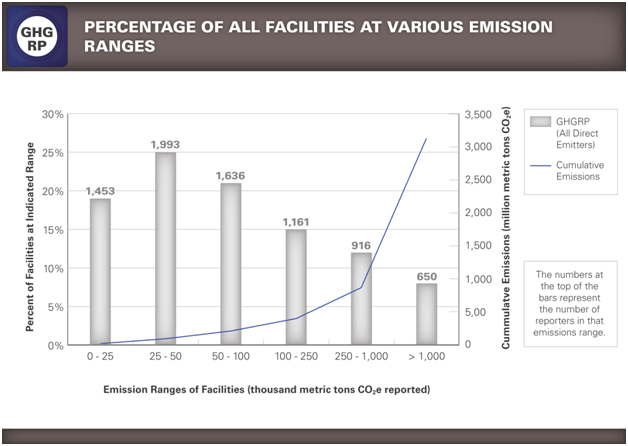
Eighty percent of reporting facilities had emissions less than 250,000 metric tons CO2e. In 2012, the 650 largest-emitting facilities—those emitting more than 1,000,000 metric tons CO2e—accounted for almost 2.3 billion metric tons CO2e. These emissions represent 72.9% of the total 3.13 billion metric tons CO2e reported. These high-emitting facilities are mainly Power Plants, but also include Petroleum Refineries, and facilities in the Chemicals and Metals sectors.
You can use FLIGHT to list and sort facilities based on total reported emissions and find the largest emitting facilities in the country or a specific state or county. This tool also allows you to sort facilities by specific industry types.
Figure 8: Facility Emission Ranges (2012)
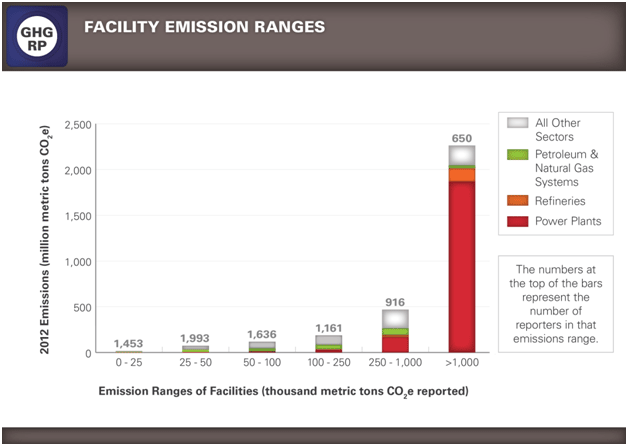
- GHGRP Calculation Methods Used
The GHGRP prescribes methodologies that must be used to determine GHG emissions from each source category. Reporters generally have the flexibility to choose among several methods to compute GHG emissions. The decision of which method to use may be influenced by the existing environmental monitoring systems in place and other factors. Reporters can change emission calculation methods from year to year and within the same year, as long as they meet the requirements for use of the method selected.
For additional information on the methodologies that reporters use to determine GHG emissions, please read the GHGRP Methodology Factsheet.
- Report Verification
All reports submitted to EPA are evaluated by electronic validation and verification checks. If potential errors are identified, EPA will notify the reporter, who can resolve the issue either by providing an acceptable response describing why the flagged issue is not an error or by correcting the flagged issue and resubmitting their annual GHG report.
For additional information describing EPA’s verification process in more details, please read the GHGRP Verification Factsheet.
- For More Information
For more detailed information from each industrial sector, view the GHGRP Data Highlights and select an industry from the text box on the right hand side.
Use FLIGHT to view maps of facility locations, obtain summary data for individual facilities, create customized searchers, and display search results graphically.
Downloadable spreadsheets containing summary data reported to the GHGRP from each reporter are available on the Data Downloads page.
All other publicly available data submitted to the GHGRP are available for download through Envirofacts.
The U.S. Greenhouse Gas Inventory contains information on all sources of GHG emissions and sinks in the United States from 1990 to 2012.
